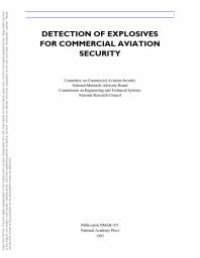
Ebook: Detection of Explosives for Commercial Aviation Security
Author: National Research Council, Division on Engineering and Physical Sciences, National Materials Advisory Board, Commission on Engineering and Technical Systems, Committee on Commercial Aviation Security
- Year: 1993
- Publisher: National Academies Press
- City: Washington, D.C., United States
- Edition: 1
- Language: English
- pdf
Security Assertion Markup Language (SAML) is an XML-based open standard for exchanging authentication and authorization data between security domains, that is, between an identity provider (a producer of assertions) and a service provider (a consumer of assertions). This book is your ultimate resource for Security Assertion Markup Language (SAML). Here you will find the most up-to-date information, analysis, background and everything you need to know. In easy to read chapters, with extensive references and links to get you to know all there is to know about Security Assertion Markup Language (SAML) right away, covering: Security Assertion Markup Language, Access control list, Access Control Matrix, Atomic authorization, Authentication, Authorization, Bell-LaPadula model, Closed-loop authentication, Comparison of privilege authorization features, Computational trust, Context-based access control, Copy protection, Cryptographic log on, DACL, Database audit, DataLock Technology, Delegated administration, Delegation of Control, Digipass, Digital identity, Directory service, Discretionary access control, Distributed Access Control System, Draw a Secret, EAuthentication, Federated identity, Federated identity management, Form-based authentication, Global Trust Council, HERAS-AF, HTTP cookie, HTTP+HTML form-based authentication, IBM Lightweight Third-Party Authentication, IBM Tivoli Access Manager, Identity Assertion Provider, Identity driven networking, Initiative For Open Authentication, Integrated Windows Authentication, Internet Authentication Service, Java Authentication and Authorization Service, Location-based authentication, Logical access control, Login, LOMAC, Mandatory access control, MicroID, Microsoft Fingerprint Reader, Mobilegov, Multi-factor authentication, Mutual authentication, NemID, NIST RBAC model, OAuth, Object-capability model, One-time authorization code, One-time password, Organisation-based access control, PassWindow, Pre-boot authentication, Registered user, Restricting Access to Databases, Richacls, Risk-based authentication, Role hierarchy, Rootkit, Salute picture, Secure attention key, Security question, Security store, Security token, Single sign-on, SiteKey, Software token, Spring Security, Strong authentication, Subscriber Identity Module, Time-based One-time Password Algorithm, Transaction authentication, Transaction authentication number, Tripcode, TUPAS, Two-factor authentication, Universal controls, Vidoop, Voms, Wilmagate, Windows credentials, ADL Registry, Advanced Distributed Learning, AppML, AS4, Atom (standard), Attention Profiling Mark-up Language, Auto-lead Data Format, Binary Format Description language, BlogML, BPEL script, BPEL4People, Business Process Execution Language, Call Control eXtensible Markup Language, Canonical XML, CellML, Channel Definition Format, CityGML, COLLADA, Common Alerting Protocol, Consegi declaration, Content Assembly Mechanism, Content Management Interoperability Services, Context management, Continuous Media Markup Language, CXML, DAISY Digital Talking Book, Darwin Information Typing Architecture, DGML, DicML, Digital Item Declaration Language, Digital Signature Services, Directory Services Markup Language, DisplayML, DITA Open Toolkit, Document Definition Markup Language, Document Object Model, Document Schema Definition Languages, Document Structure Description, Document Type Declaration, Document Type Definition, EbXML, EbXML Messaging Services, EbXML RegRep, Election Markup Language, Embedded RDF, EMML, EMML (Motorola), Emotion Markup Language, Enterprise Privacy Authorization Language, EventsML-G2, EXSLT...and much more This book explains in-depth the real drivers and workings of Security Assertion Markup Language (SAML). It reduces the risk of your technology, time and resources investment decisions by enabling you to compare your understanding of Security Assertion Markup Language (SAML) with the objectivity of experienced professionals.
Download the book Detection of Explosives for Commercial Aviation Security for free or read online
Continue reading on any device:

Last viewed books
Related books
{related-news}
Comments (0)